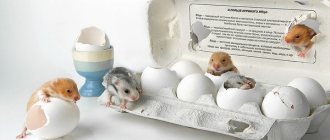At home, breeding of Syrian hamsters can occur all year round. But before you start breeding rodents, owners should learn all the intricacies of this difficult matter. After all, in order to ensure the production of healthy offspring, it is necessary to know the rules for selecting pairs, choosing the time for mating, and the features of feeding, care and maintenance of pregnant females.
Breeding hamsters
When breeding hamsters, the following main factors need to be taken into account:
- hamsters kept together do not get along very well, so the male and female should live in separate cages, they need to be brought together on neutral territory, and under the supervision of the owner. An exception to this rule is Roborovsky's hamsters;
- at the time of the first mating, both the female and the male must be at least four months old;
- after the next birth, the female must have at least two months before the next mating;
- A female older than one year cannot be bred.
Interesting facts and myths
In ancient times, hamsters were associated with evil spirits and witchcraft.
A hamster is not a toy, but a pet that requires attention and proper care.
Now they are shrouded in completely different myths:
- These are living toys. A hamster should not be considered a toy. It requires care and respect. The animal can be tamed, but it will take effort.
- It is impossible to get rid of the cage smell. If the filler is replaced in a timely manner, there will be no unpleasant odors. The hamster is clean.
- The pet does not need water. This is wrong. Without drinking water, the animal will die.
Interesting Facts:
- The animals are used in laboratory research. They are susceptible to human viruses and have a similar tooth structure to ours.
- Matriarchy reigns among rodents of this species. The female is larger than the male and decides who will be the father of the offspring.
- In England there is a club of golden hamster lovers, which publishes its own newspaper and regularly selects a hamster of the month.
How do hamsters mate?
First you need to determine the female's estrus period. Estrus occurs once every 3-5 days, its duration is from four hours to a day. You can recognize its occurrence by the following signs:
- during the period of estrus, the female secretes a substance that has a sharp musky odor;
- mucous discharge is observed in the tail area;
- she becomes restless and may run around the cage from corner to corner;
- may refuse his most favorite treat;
- makes specific sounds.
As for males, everything is simple here, they are able to mate from the fifth week of life and this ability persists almost throughout their entire life.
As already mentioned, mating should take place on neutral territory, so prepare a cage or just a cardboard box in advance. Keep in mind that if the female has not yet come into heat, a conflict may well arise between her and the male - the bulls are ready to separate the fighting, and in this case it is better to prepare a pair of gloves.
If the time for mating is chosen correctly, and the hamster is quite friendly towards the gentleman, mating will occur, which can take 5-20 minutes. After everything happened, the hamsters are seated in their home apartments.
Article on the topic: How hamsters give birth, what to do during and after childbirth
If the female does not come into heat 3-5 days after mating, then the mating process was successful and the female is pregnant. However, pregnancy does not always occur immediately after the first attempt. During the next period of estrus, you can try mating again until the desired result is achieved.
Most often for breeding it is recommended to have 1 male for 2-5 females. In some literary sources, cages with females are advised to be placed around a male’s cage. The male cell is connected to the female cells using special connecting pipes. The diameter of the pipes is selected so that the male can easily move along them (approximately 4 cm). So that only the male can get into the cages of the females, and the females cannot get into other cages, a collar made of synthetic material is put on them. This ensures that there are no fights between pets.
Time of onset of puberty
Female hamsters can become pregnant as early as 1–1.5 months of age, and some males are capable of fertilization as early as the third week of life. Because of this low threshold for sexual maturity, hamsters are separated before active growth and bone formation are completed.
The recommended age for first mating for females is 4–6 months. The next one is at 8–10 months. The animal between births should recover from 2 to 4 months. The ability to give birth in females remains for one and a half years. Males are capable of fertilization throughout their lives. They can be allowed to mate for the first time after 5 months. In males, frequent mating is also undesirable, since there is a high probability of exhaustion and deterioration in the quality of the offspring.
Pregnancy and birth of hamsters
A hamster's pregnancy lasts on average only 14-19 days, while in Djungarian hamsters the pregnancy can last up to 30 days. On the tenth day, visible signs of pregnancy appear, and it is from this moment that the expectant mother’s weight begins to rapidly increase. If the female's weight decreases during pregnancy, this may indicate illness or death of the embryos inside the womb.
Approximate duration of pregnancy for:
- Syrian hamsters and Roborovsky hamsters – 16-17 days;
- Campbell's hamsters and Siberian hamsters - 19-20 days.
Expectant mothers move very carefully, trying not to make sudden movements. Do not disturb a pregnant female unless absolutely necessary! Include more protein in her diet (this could be egg whites, cheese, cottage cheese, baby meat food, etc.).
3 days before giving birth, the female’s thirst increases. During this time, the water should be changed at least 3-4 times a day.
Labor usually begins at night. Set up a house or nest in the cage in advance (you can use a cardboard box). The hamster arranges everything inside the nest herself, just don’t forget to provide her with soft paper, napkins and hay. The cage where the hamster will give birth should be in a quiet and peaceful place.
Usually the pet copes well with the birthing process on its own, and in the morning the owners discover a new baby. Hamsters are born in a shell, the mother gnaws it in the area of the baby's head, and the baby takes its first breath. Each hamster litter can have anywhere from four to eighteen babies. Babies are born completely helpless, deaf, blind, tiny, their skin is thin and red. The only thing that babies have perfectly developed is the ability to distinguish smells.
Article on the topic: Red-eared turtle eggs, how to determine pregnancy and what to do if the turtle laid an egg
Experienced breeders and veterinarians can help with the birthing process when a female is giving birth for the first time or when a large number of babies are being born.
But there are times when during the birth process the help of a veterinarian is necessary, namely:
- if, with obvious contractions and pushing after 15 minutes, there are no results
- After the birth of the first baby, after 30 minutes, the remaining babies are not born.
Within 30 min. After giving birth, a healthy mother will definitely eat before starting to feed her babies. Refusal to eat may mean the occurrence of any postpartum complications. The vaginal membrane closes in the first two days after birth, and at this time you may notice slight bleeding from the birth canal.
The first time a hamster usually gives birth to 4-5 babies, subsequent litters can include many more babies.
Caring for Hamsters
After birth, during the first week, hamsters cannot be picked up. Having smelled someone else's scent on the cubs, the mother will most likely eat them. The desire to pet the babies should be postponed until the fur appears, which will happen in a week.
For the convenience of mother and babies, it is recommended to put a napkin or soft paper in the cage, with which the female covers the cubs when leaving them to eat. 5 days after birth, the cubs can already squeak demandingly; on the twelfth day of life, the hamsters begin to slowly crawl out of the nest and explore the surrounding space. Babies' eyes open only 2 weeks after birth, and around this time they begin to feed on their own. At this time, you can put a little porridge and carrots, grated on a fine grater, in the baby's cage. A healthy mother with a large amount of milk can feed her cubs for up to a month, and this has a positive effect on the health and strength of the hamsters.
At the age of one month, hamsters are placed in cages: boys in one cage, girls in another. This is done in order to prevent early unwanted pregnancy. Hamsters live in their new home for another 1-2 weeks. During this period, hamsters are tamed and played with. Hamsters can move to a new home with new owners at the age of 5-6 weeks.
Article on the topic: How long do hamsters stay pregnant, how to recognize and determine pregnancy in Djungarian and Syrian hamsters
Which litter to choose?
Since hamsters naturally make their bedding in their burrows, they also need it in their cage.
Therefore, it is important to decide on the right choice of filler materials. Examples of what you can put in a hamster's cage are described below.
The best option is soft paper, shredded into pieces or sawdust. But when choosing paper, avoid using newspapers or other printed materials.
The sawdust should not be too crushed, because the animals inhale wood dust and sneeze. Also refrain from using cedar and pine materials as they may cause allergies due to the presence of resins
When wondering how much sawdust to pour into a hamster’s cage, pay attention to the fact that the animal does not “sink” into the depths of the bedding, but can bury itself in it. They also use fillers specially designed for rodents, and crushed corn cobs with grain residues, as well as tree leaves.
Answering the question whether it is possible to put cotton wool in a hamster’s cage, experts warn that the use of this material is dangerous, because the pet can get entangled in its fibers and injure its paws.
Pour a layer of filler from 6 cm - this depth is enough for the hamster to burrow into it. At low temperatures in the room, it is advisable to enlarge the bedding ball so that the pet can completely hide in it.
Maintaining cleanliness in the animal’s cage is a condition for its health, because then there will be no unpleasant odors, and the chances of developing infections in the hamster will be minimized.
Problems when breeding hamsters
Cubs can be born dead, die during childbirth, or become victims of a negligent mother.
Dead cubs can be born to a healthy female for the following reasons: infection, disease, poor nutrition, poor diet during pregnancy, lack of essential vitamins and microelements in food.
Often a pregnancy, especially the first one, ends with the hamster eating the babies. There are quite a few reasons for this:
- improper diet during pregnancy, in particular, insufficient amount of animal protein in the diet;
- the failed mother is too young;
- stress or fear after childbirth;
- in the cage where the hamster gave birth, there is a male who poses a threat to her babies, and therefore she directs aggression either at the male, and if this fails, then at the babies;
- regulation of the number of offspring (a female hamster has 5 or 6 pairs of nipples, and so many babies can be born that she will not be able to feed them all);
- if the baby was born weak, sick or with a birth defect;
- if a person picks up a small hamster in his arms in the first week after giving birth, which causes the baby to develop a foreign smell.
There is also a situation when the cubs die due to the excessive care of the mother, when, worrying about the safety of the offspring, she constantly moves the cubs in search of a safer place.
Babies can be born completely healthy, and yet die in the first week of life. This may happen due to the fact that the female is not able to fully feed her babies (insufficient amount of milk or its complete absence).
Poor nutrition, lack of drinking water, heat in the room where the cage with a pregnant female is located and stress can cause the death of a hamster just before giving birth or at the very beginning of feeding newborns. This condition is often called hamster pregnancy toxicosis. Signs of pregnancy toxicosis in females: lack or decreased appetite, dull and tousled fur, muscle spasms, and drooling.
Attempts to cure this problem are unsuccessful in most cases. Prevention is important here - providing the most comfortable conditions for a pregnant hamster (constant humidity and air temperature, absence of drafts, peace and quiet, as well as a properly formulated diet and access to fresh, clean water).
Article on the topic: Newborn hamsters: how to properly care for babies, growth and development
Hamster hygiene
Long-haired animals need to be brushed regularly. You should pay attention to their hind legs and belly, as tangles often form in these areas. For hamsters with short fur, clean it with a damp brush. These rodents should be bathed only when they are very dirty, using a special shampoo.
To maintain the normal condition of hamsters' teeth, it is recommended to leave branches of fruit trees in the cage. Solid food is required for grinding down the incisors. If the teeth grow too long, you will have to contact a veterinarian. The claws of healthy and active individuals grind down on their own. They only need to be trimmed on old animals that don’t move much.
How do hamsters reproduce?
Syrian hamsters are inherently solitary, and this makes mating particularly difficult, as a female or male must only be introduced into another hamster's cage if the female is in heat to avoid serious fighting. Breeding Syrian hamsters requires patience from their owners.
Breeding Syrian hamsters requires patience from their owners
Estrus in domestic rodents
The female Syrian hamster goes into heat every 4 days (although this can vary from 3-5 days). At this time, she is more active and receptive to the attention of a man. Females come into estrus in the evening and can remain for 4 to 24 hours. Before this, the female usually emits a strong musky odor, and this is often noticeable during the summer months. The day after this, the hamster produces a thick white discharge from the vagina, and white discharge may sometimes appear in the urine.
During the winter, females may stop being in heat, and this can be helped by extending their daytime hours, turning on lights for 12 hours every day for a few days, and feeding vegetables.
Syrian hamsters should only be brought in for mating when the female is in heat. Even so, the male should not be introduced to the female on her territory, as she will be fiercely protective of her. The female should be introduced into the male's cage or she should be introduced into neutral territory.
It is best for mating to take place on neutral territory
If a female is suspected of being in heat, she can sometimes be "tested" by stroking her back towards her tail. The female will “freeze”, her body will be pressed to the floor, her head is directed forward, and her tail is in the air.
If there is any doubt as to whether the hamster is in heat, it is usually recommended to introduce rodents of both sexes into the cage so that they can be easily separated if a fight occurs. It is also wise to wear gloves or have a handy object that can be used to separate them if a fight does occur, as attempting to separate a female and male fight with bare hands is not recommended. If the female is not receptive to the male, she should be removed and repeated the next evening until she is receptive.
Related article: Why hamsters eat their babies and each other
How do hamsters mate?
When introduced into the cage, the male should begin to fuss around the female, and if she is receptive, she should "freeze" her tail in the air. A male who has not yet bred may seem a little embarrassed and try to mate from all angles, but will usually take too long to think about it.
Females who have not been mated before are not always tolerant of this confusing mating attempt from virgin males. Females who have mated before appear to be more tolerant of these attempts. Mating is often more successful if the male or female has been previously bonded and experienced.
The male will mount and push the female several times before mating. The male will mate with the female several times, and the mating of the hamsters will continue for 20 minutes, unless they lose interest before this time, in which case they should be separated and returned to their cages. Gentle biting of the female's skin is common behavior for some males, but this is normal and usually nothing to worry about, although the female may become irritated in a very enthusiastic male.
The male will mate with the female several times, and mating hamsters can last for 20 minutes
It is not always the case that a hamster becomes pregnant after the first mating, and some males may need to mate several times before a successful pregnancy occurs. Very often, males show no interest in mating, and this happens most often in winter, when it is colder. Very rarely, a male may not be interested in mating at all.
Pregnant hamsters usually do not go into heat after pregnancy, and therefore the pregnancy can be "checked" if a white discharge does not appear from the genitals 5 days after mating.
The female usually becomes sterile once she reaches 12-14 months of age, but may still be in estrus.
When to place rodents?
The sudden appearance of a cat next to hamsters preparing to mate, or an unexpected sharp sound can drive the animals into severe stress. They are capable of not only abandoning the task assigned to them, but also starting to fight. The mood of those getting married changes very quickly, regardless of their type. Fights can be so serious that one of the animals is severely injured or killed. Usually the strongest blows go to the male.
The following describes situations in which it is better to postpone mating of hamsters until better times:
- The girl initially did not like the male. In this case, you need to introduce the hamsters gradually or choose another boyfriend for your pet.
- The girl is not ready. If the hamster is not currently in heat, she will react especially aggressively to a furry man who appears nearby. Be sure that the lady will use not only her claws, but also her teeth. In such a situation, it is necessary to urgently remove the Djungarian boy and wait for the moment of estrus.
- Sudden fear. Due to stress, both hamsters can simply go wild and start fighting. In this case, their separation is necessary.
- The process is over. Not all hamsters, unlike individuals of the opposite sex, are ready to copulate all night. When the female decides that she has had enough, she will become restless and begin to show bouts of aggression. In this case, the partner should also be removed.
Sometimes hamsters can be left alone for half an hour to do their simple task. But you can leave only if the pets have established contact and they treat each other favorably. Still, it’s better to be nearby in case of a hamster force majeure. Usually the gentleman manages to inseminate the female within half an hour, then he can be separated.
By the way, some rodents have no complexes at all: they manage to mate in the presence of their owners, almost sitting in their arms!
In the photo copulating Syrians:
Pregnancy and birth of hamsters
The gestation period of Syrian hamsters is 16 days, so the female usually gives birth 16 days after the date of successful mating. Very rarely she will not give birth until the 17th or 18th day. The female usually begins to show pregnancy approximately 10 days after mating. Her belly will be swollen and her nipples will become more visible.
Article on the topic: Reproduction of hamsters at home
During pregnancy, she needs to be given high protein foods such as broken or boiled eggs, wheat, cheese and tofu. The female's feeding may continue until several days before pregnancy, when it is best kept to a minimum. It is also a good idea to remove the wheel a few days before birth and while the mother is breastfeeding. The cage should be cleaned two days before the expected due date and the female should be provided with sufficient suitable bedding. She should be disturbed as little as possible during the expected birth.
If a pregnant female does not give birth after 18 days, this usually indicates a phantom pregnancy or problems with labor. The vet can induce pregnancy, but it is very difficult and most vets will not want to do it. If the female is not showing signs of giving birth, this is usually not a big concern as the babies will be reabsorbed into the bloodstream without harming the animal. However, if the female appears to be having difficulty giving birth or appears sick, then a veterinarian should be contacted immediately. Syrian hamsters usually give birth during the evening, night or early morning, but sometimes give birth during the day. The female is active until the moment of birth. Before she delivers each baby, she tightens her abdominal muscles two or three times, then sits and squats as she delivers one baby within a couple of minutes.
If a pregnant female does not give birth after 18 days, a veterinarian should be consulted.
The placenta, which looks like a small red blood sac, can be released after each baby is born and is usually eaten by the mother as it is a good source of protein. Babies are born at approximately 10-minute intervals, and the mother may be active between each birth. Therefore, babies may be born all over the cage, but the mother will usually collect them all and place them in the nest once the birth is complete.
After the female has given birth, blood stains often appear on the bedding or around the cage. This is caused by the passage of the placenta and is normal and nothing to worry about. Heavy bleeding in a female, however, should be a cause for concern.
Article on the topic: How much does a chinchilla cost in a pet store, nursery and market
Baby hamsters are born naked, blind and deaf, weighing only 3 grams. They are born with teeth that allow them to suck, and their skin is transparent and milk can be seen in the stomach after feeding.
Why you shouldn't breed hamsters
Before you start breeding hamsters, you need to decide for yourself whether you are ready to devote enough time to caring for rodents. You need to think about all the nuances before purchasing the first pair of animals, because then it will be difficult to understand where to put the offspring.
Very often it is not possible to sell pet rodents profitably, and the owners simply take them to the market or to pet stores. In the latter case, one can only hope that the animals will not become food for the snakes. That is why hamster breeders are, first of all, people for whom this business is a kind of hobby and only then a business. Below are the main problems that breeders face in the first months of breeding hamsters.
We recommend reading which is better to get - a rat, a hamster or a guinea pig.
Affects the health of the female
Quite often there are situations when a pregnant female weighs less than 120 g. In this case, it is very difficult for her to give birth, and she may even die during childbirth. This happens if the partner with whom mating took place was much larger. It is also impossible to avoid pathologies of the birth process with rodents that are older than 14 months. Although hamsters live up to 3-4 years, the rest of their life after a year is considered old age for them.
In addition, it should be remembered that during bearing and feeding their offspring, females lose up to 30% of their body weight. If the animal was initially small, there is an increased likelihood that the body will be completely exhausted and the animal will die. Even if such a female manages to survive, she will no longer be able to reproduce.
During pregnancy, the female cannot act as a pet
It is also worth understanding that, being “in pregnancy,” the female is not a pet with whom you can constantly play. The last week before giving birth is a period when the hamster needs complete peace and quiet. Also, she should not be picked up in the next three weeks after birth. Otherwise, she may not recover or eat the offspring.
It is worth understanding that if you get a hamster for a child, then it will be very stressful for him to see how a hamster kills her children. This should definitely be taken into account by parents who decide to have a furry pet in order to teach their child to be independent.
It is useful to know the rules for taming a Syrian hamster.
Even if the young animals are already covered with fur, and you decide to pick up the rodents, you should not give them to children first. First, you need to accustom the rodents to the hands of adults, since small hamsters very often behave aggressively, bite and try to slip out of the hands. Adults will have to make enough efforts to make the young animals socially adapted.
Breeding Syrian hamsters at home
All Syrian hamsters are capable of producing offspring in captivity. Reproduction is a very responsible and important moment for those who decide to have a rodent at home. It is necessary to provide proper care and concern for the female and her offspring. The offspring that are born will grow up healthy and bring joy to you and your children. By presenting small, healthy hamsters as a gift, you will pleasantly surprise and greatly delight your friends and family. In this article we will look at preparing for breeding and caring for hamsters during and after birth.
How do Syrian hamsters reproduce at home?
Caring for a hamster is very simple, even children can handle it. You just need to explain all the nuances of feeding and care. Breeding Syrian hamsters at home requires responsibility and care.
Room equipment
It is necessary to choose a place to place the cage so that it is spacious, away from noise and dust. The cage should be located away from direct sunlight. It is necessary to frequently ventilate the room, but at the same time strictly avoid drafts.
In order for the reproduction of Syrian hamsters to be successful, it is necessary to prepare several cages:
- A large and spacious cage where the female will be with her offspring after giving birth. In this cage you need to equip a queen cell where the birth will take place. You need to add a small layer of sawdust to the bottom. It is extremely necessary to arrange an active area so that there is a place where kids can frolic. The spinning wheel, rungs and ladders are perfect for outdoor activities.
- Cage or box for mating. Here you can get by with a small box; it needs to be free of distracting objects (wheels, ladders). You can add sawdust or special filler to the bottom. It is important to place the box where it is inaccessible to children, cats, dogs and other pets.
- An additional cage where, if necessary, the Syrian hamster can be placed in case of any aggression from other animals.
Article on the topic: Reproduction of Djungarian hamsters at home: information on breeding and mating
Purchasing rodents
A lot depends on the choice of partner for mating. Breeding Syrian hamsters is a responsible matter and must be taken seriously so as not to endanger the lives of the entire Syrian hamster family. A pair of the opposite sex should be of the same breed as your pet. Hamsters should not be closely related to each other, otherwise brother and sister may produce weak offspring with signs of pathology and physical inferiority.
It is important to be able to distinguish a male Syrian hamster from a female. Only healthy rodents without diseases or transmittable infections are allowed for mating. The coat of the purchased animal should be shiny, thick and without bald spots. The eyes and nose should be clean and free of discharge. It is also worth paying attention to the emotional state of the hamster. In a normal state, the animal behaves actively, showing interest in everything new, without being afraid of an outstretched hand. However, too energetic behavior of an animal should alert you, as well as too apathetic behavior.
To give your pet time to get used to a new territory, you need to buy a Syrian hamster at a young age. After purchasing a partner, hamsters should be kept separately from each other so as not to suffer as a result of aggression from the partner. Mostly females show aggression, not allowing the male to approach them. They are favorable to their partner only during estrus, which lasts 3-4 days.
Syrian hamster: reproduction
Syrian hamsters reach sexual maturity when they are between 1 and 2.5 months old. But at this age it is not recommended to mate, since the delayed physical development of the female can negatively affect the bearing and feeding of offspring. The female may not have enough milk for large offspring. Therefore, it is worth involving a female in breeding for the first time no earlier than when she reaches three months of age. If your first birth occurs after she is six months old, there is a risk of complications during pregnancy and childbirth. The male is capable of healthy fertilization at the age of 3 months to one and a half years.
Article on the topic: How turtles reproduce in nature and at home
Before mating begins, you need to find out when the female is in heat; it is on such days that you can place a male with her. The main signs of estrus in a female Syrian hamster are similar to other animals. She becomes more active than usual and can stand up, arching her back and spreading her paws. Under the tail you can notice a mucous discharge with a pungent odor. Syrian hamsters are nocturnal animals; they are active mainly at night, including mating. Estrus can begin in the evening and last until the morning. It is necessary not to miss this moment and place a male with her. The next chance will be only in 4-5 days. If you are sure that the right moment has come right now, you need to carefully bring the male to the female. After sniffing each other, the girl can stand up, thereby showing her consent. Now you need to leave the couple in a quiet, calm place for the duration of mating and not disturb them. Half an hour will be enough for conception; during this time you need to be careful and, if the female becomes aggressive, immediately isolate the male from her. There have been cases when a female bit her partner to death.
bookkeeping, accounting, record keeping
There are generally accepted rules for keeping records in livestock farming.[8] These techniques can be applied to any breeding program and are commonly used in Syrian hamster breeding programs.[8]
Larger breeding operations will almost certainly need to be managed using a digital database.[8] Smaller breeding operations still use paper records.[8]Minimum records typically include the following information:[8]
- animal source
- identification of blood fund or voltage
- name of the person managing the animal
- relevant dates Date of birth
- dates of key interactions such as medical interventions
- Date of purchase if purchased from an external source
Record keeping may include details about the environment and conditions of care.[8] Records may be kept of ambient temperature, humidity, light cycles, when pens are cleaned, what food is provided, and who has access to the animals.[8] Medical records may include medical observations, diagnoses of any medical conditions, and notes on any medical services received by the animals.[8]
What to do after mating?
When the mating process of Syrian hamsters at home comes to an end, you need to immediately transplant the male. The female herself will make it clear by her restless behavior that it is time for her partner to leave. In cases where mating of this pair does not occur for the first time, the hamsters get used to each other and can behave calmly. Even if after mating the female behaves with restraint, it is still worth protecting the male and placing the hamsters in their own cages. During this period, the male behaves actively and spends a lot of energy, so after mating he must be fed to restore his strength. From now on, the girl needs to be given food with a high protein content for the healthy development of pregnancy.
Choosing a place to mate
For the breeding of hamsters to produce results, the couple in love must be left alone. The owners will only disturb the animals and distract them from their work. Many are worried that the boy and girl will not understand why they were put together. But this is stupid! In the wild, animals somehow find each other on their own and calmly reproduce. So why shouldn’t small pets cope on their own, because no one has canceled their instincts!
First, you need to find a cozy corner in your home where there will be no drafts, noise and threats in the form of curious pets. The marriage bed is placed there. It is best to keep hamsters not in a cage, where there are a lot of distractions (a wheel, other toys, food), but in a separate box made of thick cardboard or plastic. But it should be spacious enough, don’t forget to add filler. If you have a spare cage, that will work too.
So, you need to place two hamsters, a boy and a girl, in a love nest. At first, you can watch your pets and see how they get to know each other. If the hamster reacted favorably to the appearance of the gentleman, then move the box with the pets to where no one will disturb them. This is how hamsters of all breeds are reproduced.
The photo shows how the Dzungarians look closely at each other.
Determining pregnancy
In Syrian hamsters, pregnancy lasts from 16 to 18 days. 10 days after conception, the belly becomes rounder. Enlargement of the nipples may also be noticed. A change appears in the behavior of the female; it can change from overly aggressive to gentle and calm. The hamster's weight increases due to improved appetite and embryo growth. She approaches the wheel and other play objects less often. The cage needs to be prepared for the appearance of offspring, it must be cleaned more often, and large sawdust must be added. Care must be taken so that the cubs cannot fall out through the bars of the cage by covering the bottom with a layer of glass or cardboard. Before giving birth, it is better not to disturb the female at all, so that she can calmly arrange a place in the house. The female's calmness and lack of stress during childbirth is very important.
Article on the topic: Reproduction of red-eared turtles: mating and breeding at home (video)
How does childbirth occur?
Childbirth lasts for 1-3 hours, depending on the number of babies. Newborn hamsters are born one after another within 10-15 minutes. It is important not to distract or disturb the female at this moment; she hears everything perfectly, and any noise can interfere. You should not touch the babies after giving birth, otherwise the female may smell a foreign odor on her children and eat them. You need to add food rich in protein to your diet: cottage cheese, boiled egg yolk, boiled chicken.
In the first 7 days, the babies do not appear in the open, and are always in the nest. Only after two weeks do hamsters begin to gradually crawl out of the nest. During this period, they open their eyes and begin to grow hair.
In order not to harm the female’s health, the next mating should be planned no earlier than in 3 months. She should fully recover after giving birth and feeding her offspring. During their lives, females give birth on average 4 to 5 times, bringing litters of 6-12 cubs. When they reach the age of one and a half years, Syrian hamsters lose their ability to reproduce.
Recommendations
- Field 1999, paragraph 43.
- ^ a b c d f g gram h i
Logsdail 2002, paragraph 112. - ^ a b c d f g gram h i j k
Logsdail 2002, paragraph 113. - ^ a b c d f f
Field 1999, paragraph 45. - ^ a b c d f f
Island, Marshall (1988).
Breeding hamsters
. New Jersey: TFH Publications. P.. - ^ a b c d f g gram h i j k l m p o p q
Logsdail 2002, paragraph 114. - Field 1999, paragraph 44.
- ^ a b c d f g gram h
Mulder 2012, p. 774-5.











